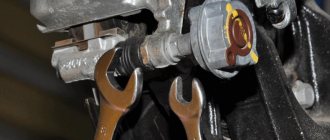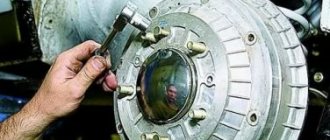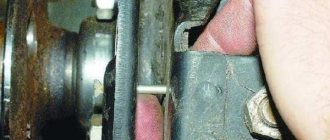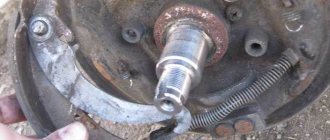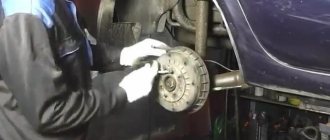Which brake drums are better, cast iron or aluminum? Compare and consider
When planning to update or change the brakes, any car owner decides which brake drums are better, cast iron or aluminum.
Before all this, I would like the brake system to work like a Swiss watch - it is the guarantee of both the life and health of the owner of the car and his passengers. And secondly: I don’t want to change the drums too much. The matter, naturally, is not very complicated, and is accessible to anyone who can hit a suitable place with a sledgehammer, and not a finger. But with all this, especially if the spare parts have become stuck, it is time-consuming, dirty and, on a physical level, not cheap. So it’s better to purchase spare parts that will not require replacement at least for a certain period of time. And the reliability of these parts may depend on various reasons, including the manufacturer and the material from which they are made.
Production technologies
Nowadays brake drums are manufactured in large quantities on an industrial basis. The most common production technology is metal injection molding using molds. It will be discussed below. Note that stamping technology is also used for drums of tracked vehicles.
Die casting is a method of producing castings in which an alloy under pressure from 7 to 700 MPa quickly fills a steel mold and acquires the required configuration.
Metal stamping is a controlled deformation process in which a workpiece changes its shape under the influence of excess pressure.
Metal injection molding
The development of a mold is accompanied by the creation of technical documentation and the determination of all parameters of the future part: wall thickness, dimensions of technological holes, location and dimensions of stiffeners, etc.
Receiving the workpiece. Aluminum alloy is poured under high pressure into a mold. A cast iron shell is first installed in the mold. After a certain exposure, the casting is removed from the mold and cools in air. Modern automatic machines are capable of providing fairly high accuracy and quality of castings, but after this the workpiece is still sent for further machining.
Mechanical restoration. When manufacturing brake drums, only the working surfaces are machined. These are the inner drum shell, which the brake pads will adhere to, and the outer mounting surfaces, which will come into contact with the hub. Additional processing of the holes used to attach the brake drum is also carried out. Read more about the “pros and cons” of fur. processing - in the footnote below.
Injection molding: advantages and disadvantages
Advantages.
1. The ability to obtain a surface with minimal allowances for machining (in our case, stiffeners, technological holes, mounting surfaces, etc.). 2. The wall thickness of manufactured products is from 0.8 mm and above. This is especially important for saving weight during casting and reducing the weight of the final product. 3. High quality surface of castings (grade 5-6). This allows you to avoid additional processing of all non-working surfaces of the drum and save time and money. 4. High strength of the workpiece. When casting under pressure, graininess in the structure of the metal is eliminated, which increases strength by 25-40% compared to sand casting. 5. Corrosion resistance and hydraulic tightness. 6. High performance.
Flaws.
1. Duration and high cost of the production process with small batch volumes. Even for a small batch of products, you need to spend time developing a mold. 2. Dependence of product quality on the quality of the mold. Defects in the production of a mold are entirely reflected in the workpieces. 3. A slight decrease in the ductility of the material associated with an increase in strength, which may limit the use of the process for parts operating under significant dynamic loads and vibrations. 4. The possibility of formation of small air inclusions in castings (air porosity), which can reduce the strength and tightness of parts.
Aluminum
It would seem that the most modern and advanced material should have become a very successful rival to classic cast iron. Its indisputable advantages include:
- Price
. Nobody likes to overpay, and our people are individual. Duralumin drums are in some places 2 times cheaper;
- Low wear resistance
. You will have to change the drums quite often, which, in fact, you would like to avoid in the first place; - Intolerance to temperature changes. So if, for example, you drive into a puddle on hot reels, expect problems;
- The aluminum drums are stuck tightly. To remove them, you almost always won’t be able to get by with an ordinary sledgehammer. And you will often have to change it (see point 1), in other words, the problem increases exponentially.
- Aluminum does not hold geometry well - the alloy is still soft. So you will have to edit them often, which does not amuse anyone.
But the worst thing is the very limited choice of manufacturers and a large percentage of defective products. People who fell for the cost and ease used to return substandard ones to merchants with correspondingly unflattering reviews. There is a worldview among the drivers that if high-quality (read: imported) aluminum were available, they would put up with some of its shortcomings.
Cast iron
The disadvantages of this material are the exact opposite of the advantages of aluminum. In other words, cast iron drums are heavy, expensive and will rust, so they need to be painted and treated with anti-rust. But their reliability is beyond praise: they are temperature stable (the handbrake does not stick even in deadly frosts), they do not creak, which often plagues aluminum, their geometry is correct from the moment of purchase and does not require adjustments throughout its service life. True, you will need to take stronger pads for them - soft ones will quickly wear out.
Another advantage is that they don’t actually stick.
: cast iron drums that have worked for years often do not even require the use of a sledgehammer.
As for going overboard with weight, this argument is somewhat dubious: in duralumin drums, the working surface is also filled with cast iron, in other words, the gain in lightness is not so great.
Additional prizes include the ability to choose a manufacturer: cast iron drums are produced by a huge number of companies.
Which pads are better to put on a VAZ?
Today there are a large number of companies on the market that sell linings for classic or modern VAZ cars. The following are the 10 best companies, according to consumer reviews and sales statistics.
10th place: AvtoVAZ
The ranking opens with a domestic manufacturer supplying serial models of pads to the market.
The brand's product range includes a full range of modifications for each car. The main advantage of the products is 100% compatibility and “tailored” to the characteristics of each machine separately. Typically, pads are used in everyday use where there is no need for increased performance or durability. The products are not suitable for fans of high-speed driving - the standard material does not like overheating, which can cause brake failure.
Users install such brake pads on the VAZ 2107 and other classic-type models.
- full compatibility with car models;
- sufficient reliability;
- moderate cost;
- durable base;
- available in every store.
- do not like overheating;
- may squeak a lot;
- a lot of debris is formed;
- do not withstand aggressive use.
Results
But the final worldview on the question of which brake drums are better, cast iron or aluminum, is something everyone makes for themselves. Almost everyone believes that there is no difference at all, although 8 kg in weight and half the cost somehow do not fit into the concept of no difference. Some people say not to take the cheapest aluminum - they say that you won’t encounter most of the problems, but the average one is completely good for the price. And there are people who are sure that the choice between cast iron and aluminum is completely unnecessary, since disc drums are the coolest of all, for which you need to save money.
Source: autoflit.ru
Lumen and cast iron
LUMEN AND CAST IRON
LUMEN AND CAST IRON
SAMARA BRAKE DRUMS - ALUMINUM OR CAST IRON?
TEXT / DMITRY ERYGIN,
Bearded army jokes about “the lightest iron in the world” came to mind with the appearance of metal brake drums for Samara on sale. We have been familiar with “lumen” for a long time, but “cast iron” is a black horse. Let's compare?
Products from Engels were entrusted to defend the interests of “ordinary” duralumin drums with metal inserts - they have proven themselves to be excellent. “Purely cast iron” colleagues arrived from the ATE office from Germany. Each side was represented by two reels - the competitors' business cards are shown below.
During the tests, we decided to check the geometry of the drums, measure their mass, evaluate static balancing, also study the behavior of the products when heated and find their static hardness. As usual, this work was carried out by NAMI specialists.
MILLIMETERS AND DEGREES
The fact that “cast iron” would be heavier than “lumen” was clear without any weighing - but by how much? It turned out that it was approximately twice as large - the mass of Russian drums was 2420 and 2460 g, respectively, and German ones - 5020 g each. Heavy, but completely similar!
There is more fuss with the geometry - exemplary dimensions are shown in Fig. 1. First, the drums were measured in the initial state, then tested with heating cycles, after which the measurement was repeated. The results are in the table. There is also data on the static imbalance of the drums.
The heating dynamics of brake pads working in tandem with our drums were determined as follows. The experimental drum was installed on an inertial shield and 15 cycles of alternating braking were carried out in a range of speeds from 120 to 60 km/h at a pressure in the shield drive of 50 kgf/cm2 with an interval of 45 s. What happened when measuring the temperature one by one is clearly depicted in Fig. 2.
Which brake drums are better, cast iron or aluminum? Read for everyone
Rear drum brakes are still quite common (although there are quite a few disc options these days). This is done for the sake of saving production on the one hand. And for the most long-term operation on the other side, on the user’s side (they walk at least 30–40% longer than the opponent). But their braking is definitely worse, and the rear disc brakes look visually better. By the way, we discussed the pros and cons here . But drum systems are not as ordinary as they seem; the difference may be the material. Now, you can distinguish between duralumin and cast iron options. Let’s talk about them specifically at the moment...
THE CONTENT OF THE ARTICLE
You can often find information on the Internet that the cast iron drum system is outdated and is rarely used. But on the contrary, the duralumin one is advanced and is currently installed everywhere! But this is not entirely true; brake drums are currently used approximately 50/50. And at the same time, some manufacturers are not shying away from cast iron, and there are significant reasons for this. Let's talk about them.
Lada Priora Hatchback 2011, 100 l. With. - spare parts
Cars for sale
Lada Priora, 2009
Lada Priora, 2011
Lada Priora, 2010
Lada Priora, 2016
Comments 77
The brake drums moved, I don’t know why, but they shuffled when braking, the sound was as if the drum had become an ellipse, today I installed cast iron drums, I’ll see what happens, but if they don’t move, it’s already good, and at the same time there will be the same characteristics, we’ll wait we'll see
